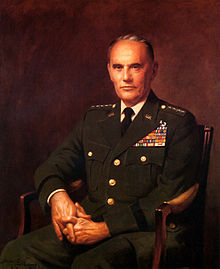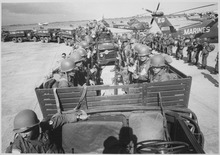Bruce Palmer
Bruce Palmer, Jr. (born April 13, 1913 in Austin , Texas , † October 10, 2000 ) was an American general in the US Army , who was among other things Vice Chief of Staff of the Army between 1968 and 1973 and in 1972 for some Time was acting Chief of Staff of the Army .
Life
Officer training and World War II
Palmer, son of Brigadier General Bruce Palmer, Sr. and his wife Madeline Harding Palmer, began officer training at the US Military Academy at West Point , which he completed in 1936. He was then a lieutenant in the 8th Cavalry Regiment stationed at Fort Bliss between 1936 and 1939 . After his promotion to first lieutenant in June 1939 was between June and September 1939 adjutant of this regiment and 1940 graduate of the cavalry school at Fort Riley . Afterwards he was in the Second World War from 1940 to 1942 first squad leader and then squadron chief of the 6th Mechanized Cavalry Regiment and received there in October 1940 the temporary rank (Temporary Rank) as captain and in February 1942 the temporary rank as major . From 1942 to 1943 he was then employed in the operations department of the General Staff in the War Ministry . In February 1943 he received the temporary rank of lieutenant colonel and was then from 1944 to 1945 Chief of Staff of the 6th Infantry Division deployed in the South Pacific ( 6th Infantry Division ) . In January 1945 he received the temporary rank of colonel . For his services as Chief of Staff of the 6th Infantry Division, he was awarded the Legion of Merit and on July 3, 1945 the Silver Star .
Post-war period and use in Korea and the Dominican Republic
After the war, Palmer was during the occupation of Korea from 1945 to 1946 commander of the 63rd Infantry Regiment and was awarded in June 1946 his promotion to the permanent rank (Rank permanent) as a captain. During his use between 1947 and 1949 as chief of planning and operations of the 1st US Army ( First US Army ) , he was promoted to the permanent rank of major in July 1948. In addition to his activity from 1949 to 1951 as a tactics teacher and head of training at the US Army Infantry School in Fort Benning , he also completed his paratrooper training. He was also a 1952 graduate of the US Army War College in Carlisle , and then from 1952 to 1954 Secretary of the General Staff and the head of the planning department in Europe stationed 7th US Army ( Seventh US Army ) . There he was promoted to the permanent rank of lieutenant colonel in July 1953. He was then commander of the 16th Infantry Regiment from 1954 to 1955 and a member of the faculty of the US Army War College between 1955 and 1957, before serving as Deputy Secretary of the General Staff and Liaison Officer to the White House from 1955 to 1957 .
In August 1959, Palmer received the temporary rank of brigadier general and was then deputy in command of the US Army War College between 1959 and 1961. Subsequently, he served from 1961 to 1962 as deputy commander in Fort Bragg stationed 82nd Airborne Division ( 82nd Airborne Division ) and was there in June 1961 the permanent rank of colonel and in May 1962 the temporary rank of Major General . Then he was from 1962 to 1963 Chief of Staff stationed in Korea 8th US Army ( Eighth US Army ) and after 1963-1964 Assistant to the Deputy Chief of Staff for planning and operations, before 1964-1965, finally, self Deputy Chief of Staff for Military Operations. In these uses he was promoted to the permanent rank of Brigadier General in February 1963 and in July 1964 to the temporary rank of Lieutenant General . In addition, he was awarded the Army Distinguished Service Medal for the first time because of his services there .
During Operation Power Pack , a multinational, US-led military intervention in the Dominican Republic that lasted from April 28, 1965 to September 21, 1966 , he acted as commander of the intervention forces (Task Force 120) and the US forces deployed there. Land Forces. He then took over until January 1966 commander of the US forces and deputy commander of the USA and six other states of the American organization states existing Inter-American peacekeeping force in the Dominican Republic. He was again awarded the Army Distinguished Service Medal for his services there.
Vietnam War and Acting Chief of Staff of the Army
In the following period Palmer acted between 1965 and 1967 as the commanding general of the XVIII already used in Operation Power Pack . Airborne Corps ( XVIII Airborne Corps ) . He was then from 1967 to 1968 in the Vietnam War commander of the II Field Force (II Field Force, Vietnam) as well as deputy commander of the units of the US Army ( United States Army, Vietnam ) deployed there . Because of his services in these uses, he also received the Army Distinguished Service Medal. In August 1968, he was appointed to the temporary rank of General transported and then took over on 1 August 1968 by General Ralph E. Haines, Jr. the post of Deputy Chief of Staff of the US Army ( Vice Chief of Staff of the United States Army ) and held this until June 30, 1972, after which General Alexander Haig later became his successor. For his services there he was again awarded the Army Distinguished Service Medal.
At the same time, he was as the successor to General William Westmoreland between July 1, 1972 and his replacement by General Creighton W. Abrams on October 11, 1972 Acting Chief of Staff of the Army ( Chief of Staff of the Army ) . During this interregnum he was in charge of the continual downsizing of the US Army in Vietnam and the army-wide innovations as well as the preparation for reform of the army organizational structure. Most recently, he was the successor to General John L. Throckmorton between 1973 and his replacement by General John J. Hennessey in 1974, Supreme Commander of the US readiness command REDCOM (US Readiness Command) . For his services there he was awarded the Air Force Distinguished Service Medal and again the Army Distinguished Service Medal. In September 1974 he retired from active military service.
After his death, Palmer was buried in Arlington National Cemetery.
Awards
Selection of decorations, sorted based on the Order of Precedence of the Military Awards:
-
 Army Distinguished Service Medal (5 ×)
Army Distinguished Service Medal (5 ×) -
 Air Force Distinguished Service Medal
Air Force Distinguished Service Medal
-
 Silver Star
Silver Star
-
 Legion of Merit
Legion of Merit
Web links
- Short biography on the Arlington National Cemetery website
- Bruce Palmer in the database of Find a Grave (English)
- Entry on the Hall of Valor page
| personal data | |
|---|---|
| SURNAME | Palmer, Bruce |
| ALTERNATIVE NAMES | Palmer, Bruce junior (full name) |
| BRIEF DESCRIPTION | American general |
| DATE OF BIRTH | April 13, 1913 |
| PLACE OF BIRTH | Austin , Texas |
| DATE OF DEATH | October 10, 2000 |

